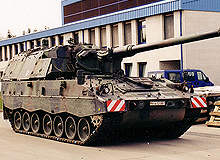
How many PzH2000NL self-propelled howitzers did the Dutch Army have in operation during its engagement in Afghanistan?
Since August 2006 our 14th Field Artillery Battalion and 11th Horse Artillery Battalion have used three PzH2000NLs out of our camps at the towns of Tarin Kowt and Deh Rawod in the Urusgan province in southern Afghanistan. At times the howitzers were positioned at tactical forward operating bases.
What tasks were the weapons used for?
Their main task was to defend the camps from attackers and provide artillery support to troops operating outside. Their operation frequency varied: sometimes they were engaged in combat for several days in a row while at other times they saw only occasional action every couple of days or weeks. However, we used them for target practice regularly.
What was a typical mission using the PzH2000NL like?
For most operations the howitzers would stay inside the bases because they have a maximum range of about 40km. If necessary, the howitzers were moved to a forward operating base to increase their range.
In most cases the cannons came into action when we had fire support teams on the ground to direct the firing.
The Dutch Army was the first to use the PzH2000NL in combat. When was this?
It was in September 2006 during Operation Medusa in Kandahar. The PzH2000NL provided fire support for ISAF and Afghan National Army forces operating against Taliban strongholds in Panjwai.
The PzH2000NL is equipped with the Multiple Rounds Simultaneous Impact fire control system. How did it prove itself in action?
It worked very well. The system allows a howitzer to hit a target 20km away with up to eight rounds. This provided us with the capability to focus fire on one point and then quickly change target. We were therefore able to use our limited number of guns much more effectively then we could have done without such a system.
What types of ammunition did you use in Afghanistan?
We fired short and long-range explosive, light and smoke grenades. In the fight for the hearts and minds of the local population in Uruzgan province, the light grenades proved especially effective, because they limited the enemy in its actions and therefore provided security and protection without causing casualties.
How was the deployment from Afghanistan to the Netherlands organised?
We airlifted the equipment to Khandahar using US C-17 Globemaster III heavy transport planes. We completed the rest of the route on flatbed trucks.
How would you sum up the Dutch Army’s experience of using the PzH2000NL in Afghanistan?
None of our howitzers had any major technical problems or needed to be replaced during their four-year deployment. They significantly extended and strengthened the operational range of our ground troops. Together with the fire support teams, the crews of the PzH2000NL provided quick and precise support for combat troops as well as the provincial reconstruction teams. The howitzers also had a discouraging effect on the enemy – just their appearance made the Taliban stop their operations.
In 2005 the PzH2000NL began to replace the M-109 A2/90 self-propelled howitzer. What improvements does it offer?
It has a greater range and can hit targets 18-40km away and, due to its advanced 155mm L52 gun, has a higher rate of fire. It also has better armour and an improved all-terrain capability. Finally, the automated loading of the 40-45kg shells has made the working conditions for the five-man crews much better. The vehicle has a good cooling system and provides protection against chemical weapons.



